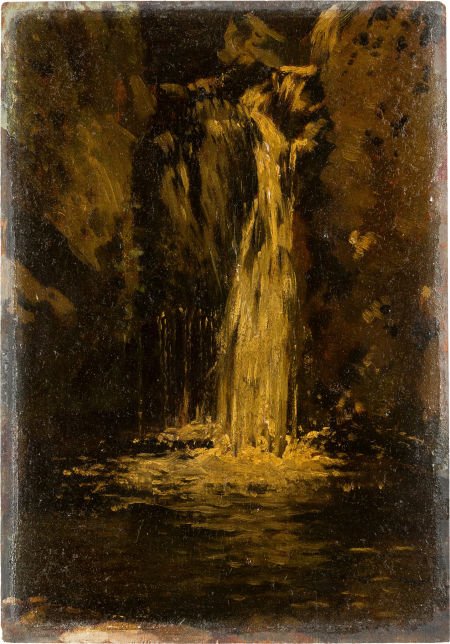So, I've now gotten a copy, and read, Michael Witwer's new
biography of Gary Gygax, co-creator of D&D and (co)founder of TSR: EMPIRE
OF IMAGINATION: GARY GYGAX AND THE BIRTH OF DUNGEONS & DRAGONS (2015).
This is clearly intended as a Gygax-friendly book, based on
extensive interviews with his wives and children. It tries to be even-handed
about some things (Gygax and Arneson's respective contributions to D&D)
while not even bothering to try on others (the events leading up to Gygax's
loss of control over TSR, Gygax's post-TSR career), where it simply presents
Gygax's point of view. It's v. readable, but the journalistic style, complete
with invented conversations, detracts from any sense that it's giving anything
resembling an authoritative account -- for that, you'd have to go to Jon
Peterson's work (PLAYING AT THE WORLD, "Ambush at Sheridan Springs",
et al).
Best thing: the
endpapers and cover art.
We're always told not to judge a book by its cover
(something most of us nonetheless do all the time), but in this case the
endpapers and cover are by far my favorite part. The endpapers are a map of
Lake Geneva with Gygax and TSR sites identified, done by an old-school TSR
employee (Stephen D. Sullivan), all on a square grid and in the non-repo blue
so familiar to gamers of my generation. The map cd serve as the basis for a
good TSR walking tour of Lake Geneva; I know it helped me sort out the relative
locations of some TSR sites that were before my time.
As for the cover, it's a clever parody/homage/reimagining of
the cover to UNEARTHED ARCANA (1985), painted by the same artist who did the
original thirty years earlier, Jeff Easley (one of the Big Four of the early
eighties: Parkinson and Elmore and Easley and Caldwell).
Things I learned:
Reading this book, I was struck by how young everyone was. Gygax was thirtysomething
when he organized the first GenCon, as opposed to Mike Carr, who was sixteen
when he ran FIGHT IN THE SKIES there at GenCon I, or Rob Kuntz, who was 14 when
he joined Gygax's wargaming group. Arneson himself a college student of
twenty-one when he met and began collaborating w. Gygax.
One gets the impression, fairly or not, that the only other
adult in the room was Don Kaye, Gygax's partner in founding TSR.
Things I Want to Know: was the term "role-playing
game" really invented in a 1976 ad for TUNNELS & TROLLS as a way to
describe a D&D-like game without using the words "dungeons" or
"dragons"? (p. 128)
Things he Got Wrong: Witwer twice
states that 2nd Edition AD&D (1989ff) was a financial flop (p. 197, 236),
saying that sales fell off by 50% when it was released. This is simply wrong.
Artistically, as a piece of game design, it was a lesser offspring of 1st
edition AD&D. But financially it was everything TSR cd have hoped: it sold
like hotcakes and revitalized the company. Similarly, he writes that SPELLFIRE
and DRAGON DICE were expensive flops, which is half-true: SPELLFIRE made money
hands over fists, while DRAGON DICE lost it in heaps.*
On the whole, I enjoyed reading this book, though I
initially skipped over the early chapters, before he'd done anything
interesting, and only came back and read about his childhood after I'd read the
rest of the book. It's entertaining, and I learned things I didn't know that
helped me put together my mental map of who came on when among the early TSR
folk. But I think the author's decision to fill the book with imagined
conversations was a real mistake: offputting.
The nadir of this sort of thing comes in Gygax's death scene:
On Tuesday, March 4,
2008, a dark-robed figure entered Gary's bedroom. Gary was immediately startled
and could do nothing but pull the covers up to his face. The figure stood
motionless at the foot of Gary's bed for several moments, its face shrouded in
darkness.
Gary tried to shout
for help, but the sheer terror of the moment prevented his vocal chords from
producing anything more than a whisper.
The form slowly raised
its arm and unfurled a bony finger toward the corner of the room, illuminating
a chess board that hadn't been there previously.
"Wanna
play?" said a raspy voice that chilled Gary to the bone.
Gary studied the
figure in disbelief and then glanced at the stately chess set. It really was a
nice set. Gary cleared his throat and sat up against the bed's headboard.
"Well . . .
" said Gary, matter-of-factly, "I never could say no to a good game
of chess."
Gary was outmatched
that day, just as he knew he would be, and the game was lost.
The legendary Gary
Gygax had passed away. But his newest adventure had just begun . . .
(p. 218)
Ingmar Bergman he ain't.
Reading this book made me wish someone would extend the
Peterson treatment to the years 1980-1995, where all the good work at TSR tends
to get ignored in accounts of both the company and that era in roleplaying
games.
--JDR
current reading: MEN & MAGIC (1st ed D&D, booklet
#1)
*actually, DRAGON DICE initially did great, but as the
original stock was selling out Management made the bad decision to re-order in
vast quantities and have the new stock shipped from China by the fastest, most
expensive method available. Only to have that new stock arrive just as the
game's brief fad was fading. Alas. --John R.



